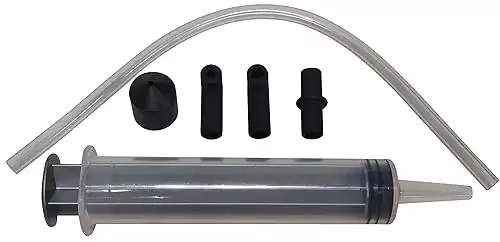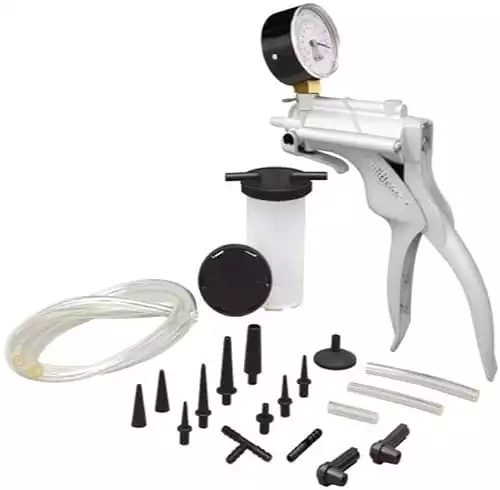In most cases, bleeding your motorcycle brakes is a simple task, but I’ve had trouble on rare occasions.
This usually happens when the brake lines are empty of fluid and you are trying to use the brake master cylinder to refill the system.
In this article, we’ll cover what stops brakes bleeding and how to fix any problems.
How Hydraulic Bike Brakes Work
Basic hydraulic braking systems are relatively simple in operation.
- Brake fluid is supplied from a reservoir
- The master cylinder piston compresses the fluid into brake lines when the lever is pulled
- This pressurized fluid is fed to the back of the brake caliper piston, which forces the brake pads into contact with the brake disc
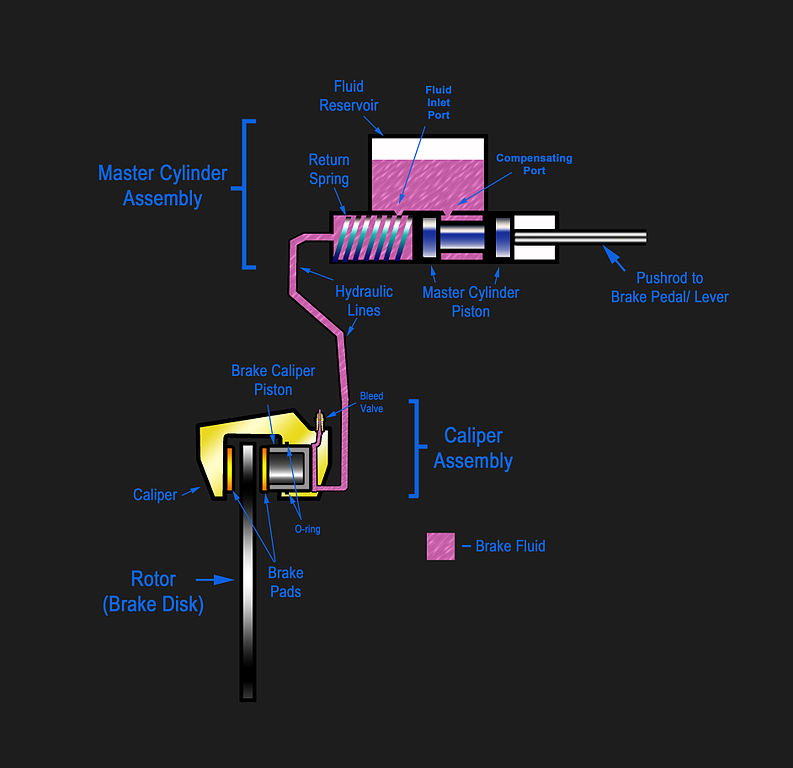
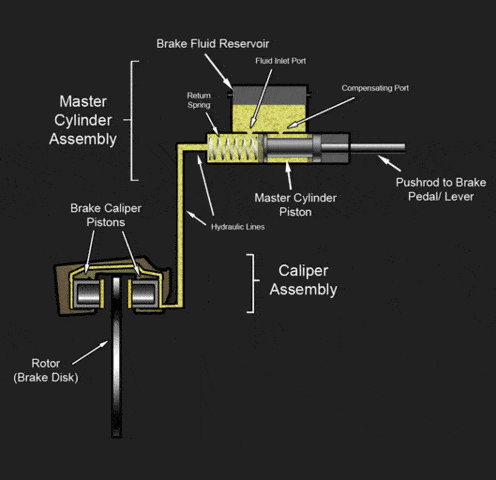
Firstly let’s take a look at the basic brake bleeding procedure, and then we will look at some common reasons why your brakes will not bleed.
Standard Brake Bleeding Technique
Although you may be able to bleed your brakes alone on a motorcycle, it is easier with a friend. With two people, one can be working the lever while the other opens and closes the bleed valve.
We’ve covered bleeding your brakes in a separate article but here is the basic procedure and a video to give you an idea:
- Remove the master cylinder top and fill the reservoir with the correct brake fluid
- Attach a bleed pipe to the bleed valve so you can catch the brake fluid
- Pump the lever to build pressure and hold the lever in on the last pump
- Open the bleed valve to allow fluid to flow
- Close the bleed valve as soon as the fluid stops moving
- Repeat steps 3 to 5 until the brake fluid is free of air, making sure the reservoir is kept topped up at all times
In most cases, the above procedure will work, and you’ll have good brakes with feel at the lever.
There could be numerous reasons why your brake system isn’t working or bleeding correctly, so let’s go through the most common causes.
#1. Brake Lines Full Of Air
Your motorcycle brakes work by transferring the pressure you apply at the lever to the back of the brake piston.
The brake lines are filled with hydraulic brake fluid, resisting the compressing forces.
In comparison, air is easily compressed and transfers very little of the brake pressure to the pads.
You’ll get a spongy feel when you pull the brake lever in, even with a tiny bit of air in your brake lines. When your brake lines are full of air after some maintenance, the brake master cylinder may not be able to push in enough brake fluid to expel all the air, or there may be an airlock.
In this case, you may have to use one of the alternative brake bleeding methods described below.
#2. Debris Blocking the Bleed Valve
Your brake calipers are subjected to a very harsh environment, being attacked by wind, rain, and salt from the road. The bleed valve should have a rubber cap to protect it, but it is still possible to get debris inside it.
If you open the bleed valve and nothing comes out, it may be blocked. The easiest thing is to remove the bleed valve from the caliper and either use an airline to blow it through or find a small piece of wire to clear the blockage.
You can also check that brake fluid comes out of the caliper when you pump the lever. Make sure you cover anything that the brake fluid may come into contact with as it is very corrosive, particularly on paint.
#3. Corroded or Damaged Brake Lines
Brake lines are very well protected, but brake fluid is hygroscopic, which means that it absorbs moisture if exposed to air.
Moisture introduces two problems:
- Air into the system
- Water that can corrode the inside of the brake line.
This is one reason why you should replace your brake fluid regularly.
Your motorcycle brake lines are a little exposed and can suffer damage. However, the lines being damaged on the brakes are more common when work is carried out.
Too many people bend the brake lines, and it was common practice in some garages to clamp the pipes to prevent fluid from escaping while they are disconnected.
The pipe’s internal diameter can be restricted in both cases, possibly causing bleeding and braking problems.
Check your brake lines carefully and if in any doubt, change them.
#4. Leaking Brake Lines
There are at least two connections between the master brake cylinder and the caliper, but there may be more on some systems. There is usually a banjo fitting and bolt at each connection, with two copper washers.
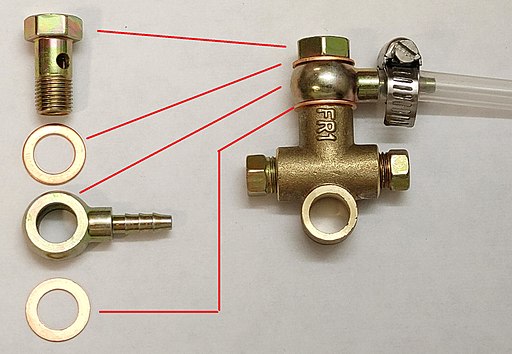
There is potential for a leak with any connection, particularly in a brake line that needs high pressure to work. Of course, air can also get in where brake fluid can escape, causing additional problems.
Check all the banjo bolts carefully for signs of brake fluid. Replace the copper washers on any that are leaking, and try to bleed your brake lines again.
It is less likely to be a leak from a burst pipe, but it can happen. Check the outside of the lines carefully, looking for any sign of brake fluid. If you are at all unsure, replace the brake lines.
The consequences of a brake line failing don’t bear thinking about.
#5. Faulty Master or Slave Cylinders
The master and slave cylinders are simply pumps, and as with all pumps, there are rubber seals inside. Internally, the cylinders have a piston with a rubber seal, a reservoir, and inlets for the fluid to flow through.
The rubber seals can wear out over time, reducing their efficiency and braking power.
New brake fluid will not harm rubber, but as it ages and absorbs moisture and other contaminants, these may damage the seals—just another reason to replace your brake fluid regularly.
I’ve never had a brake master cylinder fail, but my Suzuki SV1000S clutch master cylinder seal failed overnight, so it can happen.
Watch this video to learn about repairing your brake master and slave cylinders.
Alternative Ways to Bleed Your Motorcycle Brakes
As a young, inexperienced biker, I couldn’t afford to take my motorcycle to a garage most of the time, so I did my own mechanics.
I was trying to bleed my brakes one time, and nothing was happening. I repeated the standard procedure mentioned above but couldn’t get any pressure at the bar.
Frustrated, I spoke to a mechanic friend – remember, this was way before we had the Internet!! – and he suggested some alternative methods.
The disadvantage of these methods is that you need some extra equipment.
Reverse Brake Bleeding
As the name suggests, this method involves putting the brake fluid into the system in reverse. Instead of pumping fluid down from the reservoir, it is pumped in via the bleed valve up to the reservoir.
Since air rises, pushing fluid down against gravity in the standard method is less efficient. By forcing the fluid up from the caliper, you are pushing the air up where it naturally wants to go in the first place.
To use this method, you need some form of pump to connect to the bleed valve, a non-return valve, and a bottle of brake fluid. Kits are readily available to buy.
Reverse bleeding is the best method of bleeding your brakes and will remove virtually all the air in your brake system.
Pressure Brake Bleeding
This is an adaptation of the standard method. Instead of using the master cylinder to pump the fluid down to the caliper, we use a pressure supply.
The pressure pump is attached to the fluid inlet in the master cylinder and pushes the brake fluid down to the caliper.
You will need extra equipment and a specialist attachment to connect to the master cylinder. This method gives good results but is slightly fiddly compared to the standard or reverse methods.
Vacuum Brake Bleeding
Using this method, you are again working from the caliper end, but in this case, you’re pulling the fluid down with a vacuum or pump.
A pump or vacuum is attached to the bleed nipple to suck the brake fluid out of the reservoir.
You must ensure that the reservoir is kept full at all times. If the level drops below the inlet, air will enter the system, and you’ll have to start over.
Conclusion
Bleeding your motorcycle brakes is usually an easy job, but sometimes you can run into trouble. I know I have!
If you cannot bleed your brakes, there may be nothing wrong, and it might just be an airlock in the system somewhere. This can happen on complicated braking systems, particularly with ABS involved.
The standard method of bleeding brakes will usually work, but to remove more air from the system and make the job easier, investing in the equipment to reverse bleed your brakes will give you better results.
Image credits
KDS444, CC BY-SA 3.0, via Wikimedia Commons. Gregzsidisin, CC BY-SA 4.0, via Wikimedia Commons